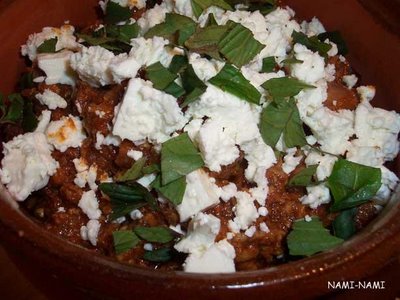"comes in two versions: with an inner tier of saucy and succulent meat between layers of vegetable, and purely vegetarian. The two versions, of course, have many small variations, almost as many as there are Greek cooks. More white sauce or less. An eggplant with no potato, or a layer of potato as the foundation. A long-simmered meat center or a quick dash of meat and spices. (p. 313)"
Thus every Greek cook has their special moussaka recipe. Hoffman says that for the topping, 'redolent nutmeg cannot be bettered as the spice to accent curdy kefalotyri cheese'. Theodore Kyriakou uses cinnamon and kefalotyri in his version. Whereas Hoffman suggests either lamb or beef, Kyriakou prescribes lamb alone. Where Kyriakou layers both aubergines and courgettes (or eggplans and zucchinis:), Hoffman prefers the former alone. This is 'my' version - and remains so, until I feel confident enough to tackle the 'proper' version.
This was the very well-received welcoming dish on Friday night. It is from BBC Good Food April 2004 issue, where it is called Hob-to-table moussaka. So don't think of the heavy, but flavoursome, oven pie dish* that is served in many a Greek restaurant. It's not the traditional layered affair at all, but cooked in the frying pan on the hob. Think of it more like deconstructing the Greek national dish, and serving it in a much lighter and simpler way. That is, omit the Saltsa Besamel and kefalotyri cheese, which have been replaced with feta cheese. May not necessarily be lighter, but it is definitely simpler.
Hob-to-table moussaka
(Pannimoussaka)
Serves 4

Ingredients:
2 tbsp olive oil
1 large onion, minced
2 minced garlic cloves
500 grams minced lamb
400 grams chopped tomatoes
2 tbsp concentrated tomato pure**
2 tsp cinnamon
200-300 grams of roasted eggplant/aubergine slices in olive oil, roughly chopped
salt
black pepper
To garnish:
200 grams feta cheese
fresh mint
Heat the olive oil on a big saucepan (feel free to use the oil drained from the eggpants). Add onion and garlic and fry gently, until soft.
Add the mince and fry until the meat is browned.
Add chopped tomatoes and tomato pure, season with cinnamon and generously with salt and pepper.
Simmer on a low heat for about 20 minutes***, adding aubergines half way through.
To serve, sprinkle with feta and mint (I used basil mint from my window sill).
Serve with fresh salad and toasted pita or plain naan bread.
Simple, delicious, aromatic, and very very Greek:)
Kali orexi!
* Susan Hoffman writes that 'The word moussaka refers to any layered vegetable casserole - only with tourism has the term become synonymous with the meat and eggplant version' (p. 316).
** Or replace chopped tomatoes and tomato pure with tomato perasti, if available (it's kind of thick and intensely-flavoured Greek tomato passata).
*** I cook the sauce for 30-40 minutes, stirring regularly and adding a bit of red wine/stock if necessary. I like the extra depth that slow cooking gives to tomato-based sauces.

6 comments:
Hi Pille, very interesting variation on moussaka. I had no idea that any vegetable casserole can be called moussaka - like everyone else I assumed it had to be aubergines, meat and bechamel. I've actually made something similar to this but using ricotta cheese instead of feta, but I'll definitely have to give feta a try!
Hi Pille, I love that! It looks great and relatively easy to make. And I love feta, sounds like it would be perfect with this. Thanks for sharing the recipe, I'll definitely try it!
Oooh! This looks yummy...and an easy way to whip up some moussaka...thanks for sharing the recipe :)
hi pille, a deconstructionist moussaka...how's that for food as art ;) i never knew moussaka referred to any vegetable casserole...thanks for the recipe and a wonderful post, as always...
Paz - glad you like it - feta cheese is such a nice addition to lots of dishes - creamy & salty..
Melissa - we use ricotta a lot in Estonia, but mainly in desserts. Had never thought of adding it to a savoury meat dish - I'll probably ask you for the recipe soon!
Michele - it was easy-peasy indeed - and I hope you'll like it, too! Although it'll probably be a while before you get tired of all the French offerings and decide to cook something else from the continent:)
Joey - I will try to make a 'proper' moussaka soon, but meanwhile this will have to do:)
J - thanks for you kind words! I'll have my Greek beau ask his mum/grandma about the exact meaning of moussaka, but indeed, Hoffman suggests it's not necessarily a meat/aubergine/bechamel affair at all.
It was a great success, I’m happy to say. As Pille, rightly, says, ‘every Greek cook has their special moussaka recipe’. So I was pleasantly surprised (and my partner too) to discover a different way to serve moussaka to the one we’re used to… as Pille’s title suggests, this recipe, in a way, ‘deconstructs’ moussaka. It doesn’t use bechamel, making it much lighter and easier to make as a quick, everyday supper.
Post a Comment